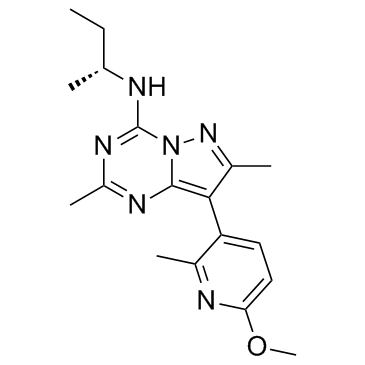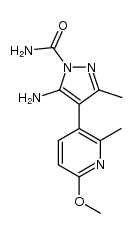| Description |
Pexacerfont is a selective corticotropin-releasing factor (CRF1) receptor antagonist with IC50 of 6.1±0.6 nM for human CRF1 receptor.
|
| Related Catalog |
|
| Target |
IC50: 6.1±0.6 nM (human CRF1 receptor)[1]
|
| In Vitro |
Pexacerfont demonstrates a potent and specific inhibitory effect (IC50=6.1 ± 0.6 nM) toward human CRF1 receptor and has greater than 1000-fold lower affinity (IC50>1000 nM) for the CRF-binding protein and biogenic amine receptors[1].
|
| In Vivo |
Pexacerfont (BMS-562086) is active in rats (1-10 mg/kg, orally) in the defensive withdrawal and elevated plus maze models of anxiety. After the intravenous bolus dose, the plasma Pexacerfont concentrations exhibited a multiexponential decline in rats, dogs, and chimpanzees. The CLp of Pexacerfont was higher in rats (17.9 mL/kg per min) and dogs (11.6 mL/kg per min) than in chimpanzees (2.0 mL/kg per min). Assuming the value of CLp of Pexacerfont approximates the value of CLb in these three species, Pexacerfont has an estimated hepatic extraction ratio of 0.32, 0.38, and 0.08 in rats, dogs, and chimpanzees, respectively (calculated by dividing CLp by respective hepatic blood flow, 55.2, 30.9, and 25.5 mL/kg per min for rats, dogs, and chimpanzees). The assumption that CLb is equal to CLp is reasonable at least in rats, where the blood to plasma concentration ratio of BMS-562086-equivalent radioactivity was 0.95 at 1 h postdose[1].
|
| Cell Assay |
Caco-2 cells at passage 50 to 60 are seeded on polycarbonate membranes of 24 well Transwell plates at a density of 60,000 cells/cm2. The cells are cultured for 21 to 25 days in culture medium consisting of Dulbecco's modified Eagle's medium supplemented with 10% fetal bovine serum, 0.5 mM HEPES, 1% nonessential amino acids, 1% L-glutamine, 100 U/mL penicillin-G, and 100 μg/mL streptomycin. Before the permeability studies, apical (AP) and basolateral (BL) media are replaced with transport buffer (Hanks' balanced salt solution supplemented with 2% N, N-dimethylacetamide, pH 7.4). AP to BL permeability study is initiated by replacing the AP medium with the transport buffer containing 25 μM BMS-562086. All permeability experiments are performed at 37°C.Transepithelial electrical resistance (TEER) values are measured to assess cell monolayer integrity. TEER values are obtained both at the beginning and at the end of each experiment. Only wells with TEER values between 400 and 500 Ω/cm2 throughout the experiment are used in the studies. Mannitol (25 or 100 μM) transport experiments are performed in the same manner as other transport experiments. Mannitol served as a probe of the Caco-2 cell monolayer integrity[1].
|
| Animal Admin |
Rats[1] One group of male Sprague-Dawley rats (n=3, 0.34-0.35 kg b.wt.) instrumented with single jugular vein cannulas are designated for oral administration, and a second group of male Sprague-Dawley rats (n=3, 0.34-0.35 kg b.wt.) instrumented with dual jugular vein cannulas are designated for intravenous administration. All rats are fasted for approximately 18 h before use and for 4 h after dosing. Water is provided ad libitum. Pexacerfont (BMS-562086) is administered orally by gavage to three rats at a single dose of 5 mg/kg in 0.5% aqueous methylcellulose. A single intravenous bolus dose of Pexacerfont is administered to three rats at 1 mg/kg in 20% ethanol in saline via the jugular vein cannula. Blood samples (0.2 mL/time point per animal) are collected via the jugular vein cannula for analysis of Pexacerfont at 0, 0.08 (intravenous dose only), 0.17 (intravenous dose only), 0.25, 0.5, 0.75, 1, 2, 4, 8, 12, 24, 48, 72, and 96 h postdose. Plasma is prepared from the blood samples by centrifuging for 10 min at 1000g and 5°C.
|
| References |
[1]. Zhou L, et al. In vitro and in vivo metabolism and pharmacokinetics of BMS-562086, a potent and orally bioavailable corticotropin-releasing factor-1 receptor antagonist. Drug Metab Dispos. 2012 Jun;40(6):1093-103.
|


![4-Chloro-8-(6-methoxy-2-methylpyridin-3-yl)-2,7-dimethylpyrazolo[1,5-a][1,3,5]triazine structure](https://image.chemsrc.com/caspic/251/459856-19-0.png)


